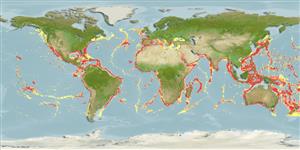Common names from other countries
Environment: milieu / climate zone / depth range / distribution range
Écologie
Benthopélagique; profondeur 165 - 2100 m (Ref. 97531), usually 400 - 600 m (Ref. 106425). Subtropical; 56°N - 51°S, 161°W - 180°E
Cosmopolitan: Western Atlantic: off South Carolina to Florida and off Bermuda; NE and SW Gulf of Mexico. Eastern Atlantic: off SW Ireland, Bay of Biscay, throughout Mediterranean, Gulf of Guinea, and Cape of Good Hope. Indo-West Pacific: from Gulf of Aden and east African coast to Japan and Hawaii; Plesionika martia orientalis: Indo-Pacific.
Length at first maturity / Taille / Poids / Âge
Maturity: Lm 1.6 range ? - ? cm Max length : 16.9 cm TL mâle / non sexé; (Ref. 434)
Also caught by pelagic trawls (Ref. 417). Minimum depth from Ref. 80357. Benthic species inhabiting muddy bottoms (Ref. 434), soft mud and coarse sand at depths of 176 to 700 m (Ref. 80357). Benthopelagic (Ref. 91956). Feeds on crustaceans (Pasyphaeidae, euphausiids) and carrion (Ref. 434).
Members of the order Decapoda are mostly gonochoric. Mating behavior: Precopulatory courtship ritual is common (through olfactory and tactile cues); usually indirect sperm transfer.
Fischer, W., G. Bianchi and W.B. Scott (eds.). 1981. (Ref. 434)
Statut dans la liste rouge de l'IUCN (Ref. 130435)
statut CITES (Ref. 108899)
Not Evaluated
Not Evaluated
Utilisations par l'homme
Pêcheries: commercial
| FishSource |
Outils
Sources Internet
Estimates based on models
Preferred temperature
(Ref.
115969): 6.1 - 14.1, mean 9.1 (based on 366 cells).
Résilience
Haut, temps minimum de doublement de population inférieur à 15 mois (K=0.31-0.73).
Vulnérabilité
Low vulnerability (10 of 100).
